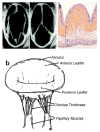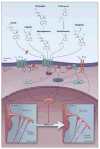Serotonin receptors and heart valve disease--it was meant 2B
- PMID: 21440001
- PMCID: PMC3179857
- DOI: 10.1016/j.pharmthera.2011.03.008
Serotonin receptors and heart valve disease--it was meant 2B
Abstract
Carcinoid heart disease was one of the first valvular pathologies studied in molecular detail, and early research identified serotonin produced by oncogenic enterochromaffin cells as the likely culprit in causing changes in heart valve tissue. Researchers and physicians in the mid-1960s noted a connection between the use of several ergot-derived medications with structures similar to serotonin and the development of heart valve pathologies similar to those observed in carcinoid patients. The exact serotonergic target that mediated valvular pathogenesis remained a mystery for many years until similar cases were reported in patients using the popular diet drug Fen-Phen in the late 1990s. The Fen-Phen episode sparked renewed interest in serotonin-mediated valve disease, and studies led to the identification of the 5-HT(2B) receptor as the likely molecular target leading to heart valve tissue fibrosis. Subsequent studies have identified numerous other activators of the 5-HT(2B) receptor, and consequently, the use of many of these molecules has been linked to heart valve disease. Herein, we: review the molecular properties of the 5-HT(2B) receptor including factors that differentiate the 5-HT(2B) receptor from other 5-HT receptor subtypes, discuss the studies that led to the identification of the 5-HT(2B) receptor as the mediator of heart valve disease, present current efforts to identify potential valvulopathogens by screening for 5-HT(2B) receptor activity, and speculate on potential therapeutic benefits of 5-HT(2B) receptor targeting.
Copyright © 2011. Published by Elsevier Inc.
Figures






Similar articles
-
Possible role of valvular serotonin 5-HT(2B) receptors in the cardiopathy associated with fenfluramine.Mol Pharmacol. 2000 Jan;57(1):75-81. Mol Pharmacol. 2000. PMID: 10617681
-
Serotonergic drugs and valvular heart disease.Expert Opin Drug Saf. 2009 May;8(3):317-29. doi: 10.1517/14740330902931524. Expert Opin Drug Saf. 2009. PMID: 19505264 Free PMC article. Review.
-
The bulky N6 substituent of cabergoline is responsible for agonism of this drug at 5-hydroxytryptamine 5-HT2A and 5-HT2B receptors and thus is a determinant of valvular heart disease.J Pharmacol Exp Ther. 2011 Jul;338(1):381-91. doi: 10.1124/jpet.111.181255. Epub 2011 Apr 25. J Pharmacol Exp Ther. 2011. PMID: 21518772
-
Safety Pharmacology assessment of drugs with biased 5-HT(2B) receptor agonism mediating cardiac valvulopathy.J Pharmacol Toxicol Methods. 2014 Mar-Apr;69(2):150-61. doi: 10.1016/j.vascn.2013.12.004. Epub 2013 Dec 19. J Pharmacol Toxicol Methods. 2014. PMID: 24361689 Review.
-
The role of 5-HT2B receptors in mitral valvulopathy: bone marrow mobilization of endothelial progenitors.Br J Pharmacol. 2017 Nov;174(22):4123-4139. doi: 10.1111/bph.13981. Epub 2017 Oct 15. Br J Pharmacol. 2017. PMID: 28806488 Free PMC article.
Cited by
-
Psychedelics and Anti-inflammatory Activity in Animal Models.Curr Top Behav Neurosci. 2022;56:229-245. doi: 10.1007/7854_2022_367. Curr Top Behav Neurosci. 2022. PMID: 35546383 Review.
-
Atypical sympathomimetic drug lerimazoline mediates contractile effects in rat aorta predominantly by 5-HT2A receptors.Bosn J Basic Med Sci. 2017 Aug 20;17(3):194-202. doi: 10.17305/bjbms.2017.2071. Bosn J Basic Med Sci. 2017. PMID: 28628756 Free PMC article.
-
Microarray analyses to quantify advantages of 2D and 3D hydrogel culture systems in maintaining the native valvular interstitial cell phenotype.Biomaterials. 2016 Jan;74:31-41. doi: 10.1016/j.biomaterials.2015.09.035. Epub 2015 Sep 28. Biomaterials. 2016. PMID: 26433490 Free PMC article.
-
Serotonin concentration enhancers at clinically relevant doses reduce [11C]AZ10419369 binding to the 5-HT1B receptors in the nonhuman primate brain.Transl Psychiatry. 2018 Jul 16;8(1):132. doi: 10.1038/s41398-018-0178-7. Transl Psychiatry. 2018. PMID: 30013068 Free PMC article.
-
2B Determined: The Future of the Serotonin Receptor 2B in Drug Discovery.J Med Chem. 2023 Aug 24;66(16):11027-11039. doi: 10.1021/acs.jmedchem.3c01178. Epub 2023 Aug 16. J Med Chem. 2023. PMID: 37584406 Free PMC article. Review.
References
-
- Abramowski D, Rigo M, et al. Localization of the 5-hydroxytryptamine2C receptor protein in human and rat brain using specific antisera. Neuropharmacology. 1995;34(12):1635–1645. - PubMed
-
- Agmon Y, Khandheria BK, et al. Aortic valve sclerosis and aortic atherosclerosis: different manifestations of the same disease? Insights from a population-based study. J Am Coll Cardiol. 2001;38(3):827–834. - PubMed
-
- Aikawa E, Whittaker P, et al. Human semilunar cardiac valve remodeling by activated cells from fetus to adult: implications for postnatal adaptation, pathology, and tissue engineering. Circulation. 2006;113(10):1344–1352. - PubMed
-
- Allen JA, Roth BL. Strategies to Discover Unexpected Targets for Drugs Active at G Protein-Coupled Receptors. Annu Rev Pharmacol Toxicol 2010 - PubMed
Publication types
MeSH terms
Substances
Grants and funding
LinkOut - more resources
Full Text Sources
Medical

